Portfolio
This Year's Models:
Notes on
the 2012 Whitney Biennial
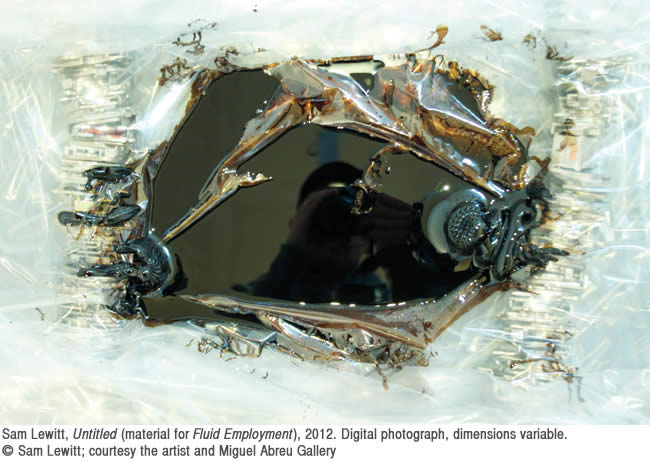
 n a corner space of the 2012 Whitney Biennial stands a Yamaha organ that, via a computer program and carefully constructed bamboo fingers, occasionally makes sounds. When I watched it, the intervals of silence between notes were often long enough that other observers, lacking the time or patience to wait, moved on. My reward for lingering, though, was an occasional, surprising moment when a clicking bamboo piece suddenly depressed a key. Four pipes leaning over the organ suggested a carefully arranged ruin, beneath which the machine’s sporadic bleats of “heavenly choir”-type sound took on the air of a mechanized attempt at survival.
n a corner space of the 2012 Whitney Biennial stands a Yamaha organ that, via a computer program and carefully constructed bamboo fingers, occasionally makes sounds. When I watched it, the intervals of silence between notes were often long enough that other observers, lacking the time or patience to wait, moved on. My reward for lingering, though, was an occasional, surprising moment when a clicking bamboo piece suddenly depressed a key. Four pipes leaning over the organ suggested a carefully arranged ruin, beneath which the machine’s sporadic bleats of “heavenly choir”-type sound took on the air of a mechanized attempt at survival.
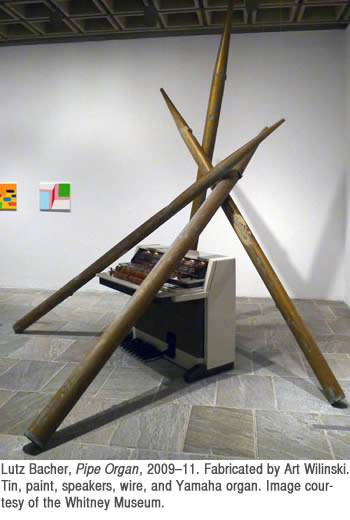 The piece—Pipe Organ, by Lutz Bacher—greatly enertained me. In a Biennial with ample space given to process-oriented items, Bacher’s organ has it both ways: while the occasional triggering of a solitary note suggested an ongoing performanc, the piece was also interesting to look at as a sculptural arrangement. In other words, it looked finished, but sounded in progress.
The piece—Pipe Organ, by Lutz Bacher—greatly enertained me. In a Biennial with ample space given to process-oriented items, Bacher’s organ has it both ways: while the occasional triggering of a solitary note suggested an ongoing performanc, the piece was also interesting to look at as a sculptural arrangement. In other words, it looked finished, but sounded in progress.
This Biennial has received high praise, and some of that may be the result of viewers finding pleasure in the dramatic tension of process. A work in the “process” stage carries a sense of potential that a finished piece no longer has, and many of this Biennial’s artists exploit the enticing suggestiveness of process. Georgia Sagri’s installation, Working the No Work, documents her work toward crafting a book she never intends to actually complete. Sam Lewitt stops by occasionally to pour more ferromagnetic liquid onto the floor—in ensuing hours, viewers can observe the substance slowly fuzz and spike like a gelatinous mold. And Dawn Kasper pulled off the sales job of talking the show’s curators into letting her move her “messy” studio space into the museum's third floor and then coming in to hang out in it during the Biennial. (I put “messy” in quotes only because as an installation, it’s of course a premeditated mess.) When Kasper walked into her space in the afternoon, put a Gary Numan album on the portable turntable, and started chatting with her friends, I couldn’t help but think that there is a line between a process freighted with a sense of stakes and a process of just hanging out, shooting the breeze, and not trying much. One is art, and the other describes my weed-filled backyard, to which I do not charge admission. Visitors can decide which side of the line Kasper is on.
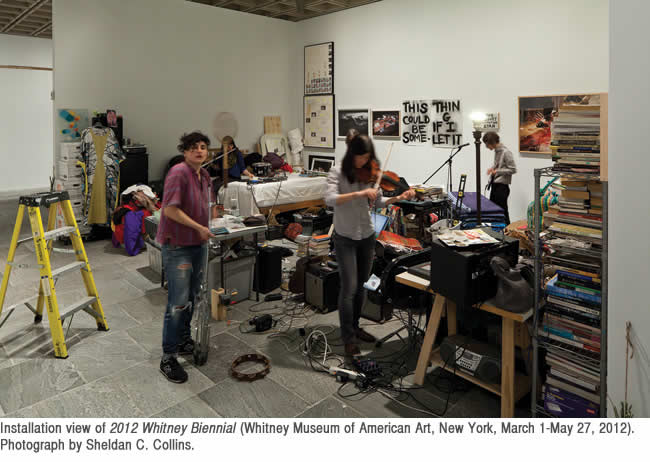
I recognize those thoughts on process reveal an aesthetic prejudice: I’m a bit of a square, and like it when artists make something. Items like Cameron Crawford’s making water storage revolution making water storage revolution—an attempt at generating “useless labor” by creating an item with neither purpose nor utility—leave me cold, and I’m always naively surprised by how often contemporary art posits itself as an intellectual exercise. When an artist contrives a project in which it’s somehow off-limits to actually try something, which means that he or she can’t possibly be accused of failing, it’s difficult not to read the situation—if you’ll forgive the therapy-speak—as a bit “highly defended.” If you don’t try, you can’t fail is how I believe people should approach the lottery, but it usually disappoints me in art.
I acknowledge this because I realized while moving through the Whitney that I’m quite drawn to investigations of process, documentations of transitional states, or examinations of change—and these kinds of pieces are present throughout this Biennial—when they also carry the vulnerability and risk of delivery in a finished state. Tom Thayer’s marionettes, animation, and suspended cardboard paintings, for instance, operate as something of a companion piece to Bacher’s organ, in that the animations are broadcast on old computer monitors, and change slowly, at times via slight jitters the inattentive eye could easily miss. The warm reds and oranges of Thayer’s work were a welcome environment, and a record of Carl Orff’s “Street Song” playing much too slowly seemed the right soundtrack for his corner of the show. Liz Deschenes’ photo monotones possess a regal grandeur, but their real power is a result of Deschenes’ skill with composition and scale. And it’s hard to find an artist more committed to a high-stakes investigation of transition than Forrest Bess, a curated collection of whose work has been given its own room. Bess, active in the 1950s and 1960s, not only painted the colorful shapes that formed his pre-sleep visions, but believed those visions offered surgically-realizable suggestions on sexual physiology. This is an artist who (between shipping his paintings to the Betty Parsons Gallery in New York) with no anesthetic other than strong drink and stronger conviction, alone on the south Texas coast where he lived and worked as a fisherman, cut a hole in the base of his penis because he felt surgically-created hermaphroditism would resolve his sexual anxieties. He not only survived, but took photos. I feel like writing something sassy like “Stick that in your Biennial!” but of course the reason I’m mentioning it is that they did.
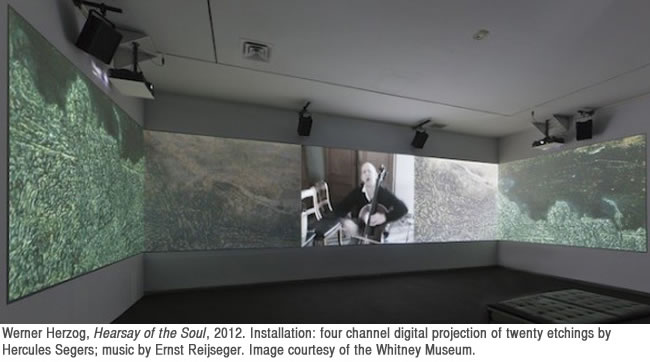
There is a stronger selection of films this year than in recent Biennials. Previous exhibitions have too often included films that were little more than simple recordings of some other art rather than explorations of the expressive range or power of film itself. The most talked about film this time around is Werner Herzog’s “Hearsay of the Soul,” certainly due in part to the director’s name recognition. Herzog’s multi-screen film juxtaposes engravings by Hercules Segers with a performance by cellist/composer Ernst Reijseger, and demonstrates that Herzog’s skills at creating momentum and intrigue are just as operative in a fourteen-minute piece as they are at feature length. Reijseger’s music invests Segers’ detailed-to-the-point-of-abstract engravings with an unnerving and engrossing spiritual resonance.
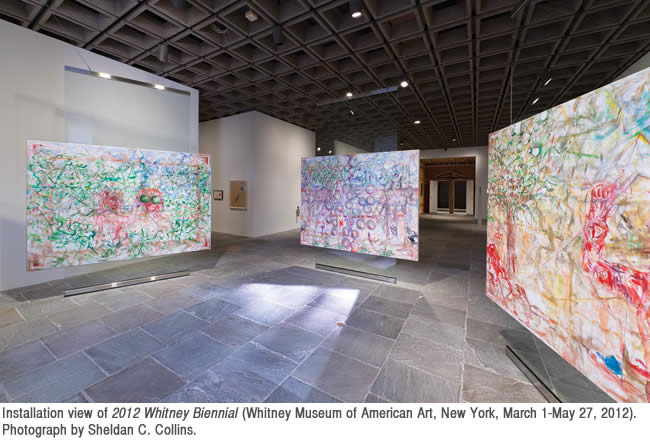
Did you know some people still just paint or dance, though? Jutta Koether’s The Seasons (pictured above) came as something of a shock, in that there was no additional element or game: they were just paintings. Andrew Massullo’s non-objective paintings carry a similar force, reminding that explorations of shape and color on canvas can result in perfectly simple pleasures. The Biennial offers a diverse selection of performances and events, as well. A one-day visitor can only experience the barest sample of these, but one of my lasting impressions of the Biennial will be the dance performance “Who's Zoo,” by the Michael Clark Company. The Company was invited to spend a four-week residency at the Biennial during March and April, to work with both professional and untrained dancers developing choreography for performance. (I felt a bit of a movie-business thrill seeing Clark—I knew him as the embodiment of Caliban in Peter Greenaway’s Prospero’s Books, a movie I love and which made every other viewer I’ve ever spoken to want to flee the theater.) The company’s performance at the Whitney incorporated participation from the non-professionals in a way that felt both authentic and playful, and the professionals seemed loose and free. Clark himself waded through, as well, entering anonymously in a hooded sweatshirt. It may be unsophisticated to admit that the day’s greatest thrill involved tapping my foot to Pulp songs performed at high volume while I watched a bunch of people dance. But it was nice, late in the afternoon on the fourth floor, to watch artists perform a finished piece in earnest, generating energy the old-fashioned way: through a whirl of color, movement, light, and heat. —Dan DeWeese
 Dan DeWeese is Editor in Chief of this magazine. His novel, You Don't Love This Man, came out last year.
Dan DeWeese is Editor in Chief of this magazine. His novel, You Don't Love This Man, came out last year.


